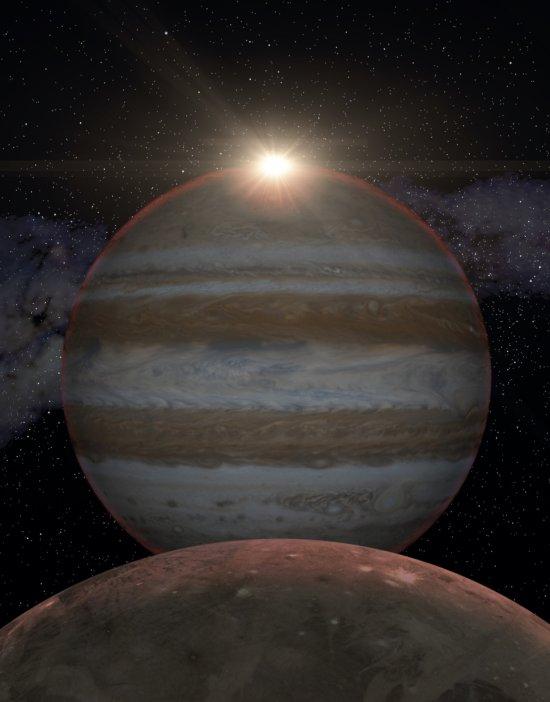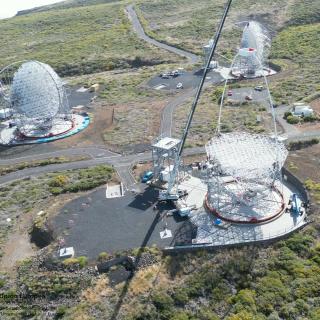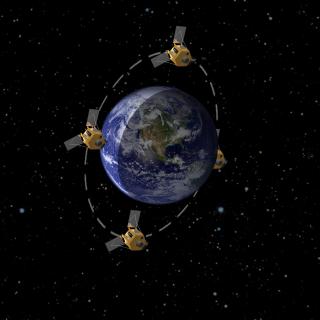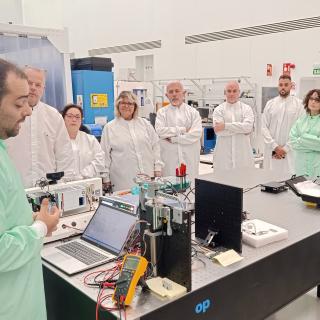The scientific journal Astrophysical Journal Letters is publishing a study, led by researchers at the Astrophysical Institute of the Canaries (IAC), which has been the subject of a report in the journal Nature. It the study Jupiter is presented as an ideal laboratory for research into exoplanets which are similar. Jupiter, the largest planet in the Solar System, has large satellites around it. The study has used the largest of the satellites, which is the biggest satellite in the Solar System, Ganymede, as a mirror to analyze the atmosphere of the planet. The observations were performed during an eclipse of Ganymede by Jupiter, and allowed the researchers to observe Jupiter as if it were a transiting exoplanet.
Its transmisión spectrum, observed as Ganymede began to be eclipsed, and could be observed through the atmosphere of Jupiter, shows strong extinction, reduction of the light due to clouds and to aerosols in Jupter´s atmophsere, as well as strong absorption in the characteristic bands of methane (CH4), and most surprising, ice crystals in a stratospheric layer. These results are of relevance to the modelling and the interpretation of transiting exoplanets, but they also offer a new technique to characterize the upper layers of Jupiter’s atmosphere, and to determine the abundance of water. It will also be useful in helping establish the rate of comet impact on Jupiter, and its consequences for the history of the formation of the Solar System.
The transit method
During the last two decades more than 1,800 exoplanets have been discovered, 65% of them using the transit method. This entails observing a star with very accurate photometry, to detect the slight drop in the intensity of its light when a planet passes in front of it. For a small proportion of these planets, those which orbit around the brightest stars, their atmospheres can be studied using the method of transmission spectroscopy, where one measures the difference between the light emitted and the light transmitted, which gives a “fingerprint” of the composition of the atmosphere. At the present time this is the most successful technique for probing the chemical composition of the atmospheres of exoplanets.
During the transit of the planet across the front face of the star, some of the light from the star is blocked, and only a ten thousandth part passes through the thin atmospheric layer of the planet (for a planet like Jupiter, and a star like the Sun), bringing with it information about its atmospheric layers and their components.
“In order to explore the limitations of this technique” explains Pilar Montañés, a researcher at the IAC and the first author of the article “ we have applied it to study the atmosphere of Jupiter. We have measured the transmission spectrum of Jupiter, observing it as if it were an exoplanet. Our method has been to take high resolution spectra of Ganymede, (Jupiter’s third satellite out) during its passage through the shadow of the planet. In spectrum obtained when we divide the spectra observed before and during the eclipse, the signals from the Sun, from the Earth, and from Ganymede itself, (which is on a synchronous orbit around Jupiter) are eliminated.”
The study shows that the strongest absorptions are due to methane, as one would expect for Jupiter. However the observation of the extinction due to clouds and to aerosol particles is also relevant. “Our results” explains Enric Pallé, an IAC researcher and co-author of the article “support previous results in which transmission spectroscopy indicated the detection of clouds and of aerosols in “hot Jupiters”. As the eclipse progresses, out method allows us to probe the atmosphere of the planet in greater depth.
However the most interesting signal which was detected, between 1.5 and 2.0 microns, is probably due to stratospheric clouds of ice crystals. “Our models,” notes Manuel López Puertas of the Astrophysical Institute of Andalucia (IAA-CSIC), “have allowed us to determine that the amount of water ice in the Jupiter's stratosphere is much larger than expected, about 1000 times higher than that previously measured in the vapour state. We have also detected spectral lines of sodium iodide (NaI) in Jupiter´s atmosphere, due either to the continual deposit of sodium from comets, or to a continual flux of sodium from the satellite Io”.
“This is the first time that this kind of observations has been performed from the ground, and have covered such a wide spectral range“ notes Beatriz González, another member of the team, who was also at the iAC when the study was carried out.
The observations were performed during two eclipses in 2012 using the LIRIS instrument on the William Herschel Telescope at the Roque de los Muchachos Observatory (La Palma), and the XSHOOTER instrument on the VLT (Very Large Telescope) at the Paranal Observatory of the European Southern Observatory (ESO) in Chile, in three spectral ranges: the ultraviolet, the visible, and the infrared. Similar observations had been previously obtained to obtain the transmission spectrum of the Earth using lunar eclipses, by Enric Pallé, Pilar Montañés, and their collaborators in 2009.
Publication: "Jupiter as an exoplanet: UV to NIR transmission spectrum reveals hazes, a Na layer and possibly stratospheric H2O-ice clouds". ApJ Letters. E. preprint: http://arxiv.org/abs/1502.02132
Authors: Montañés-Rodríguez, P. (IAC); González-Merino, B. (IAC); Pallé, E. (IAC); López-Puertas, M. (IAA, CSIC); García-Melendo, E. (UPV).
Article in Nature: http://www.nature.com/news/jupiter-glimpsed-as-aliens-would-see-it-1.16926
ANIMATION bia.iac.es/videos.php?id=3&vid=191
Contacts:
- Pilar Montañés Rodríguez (IAC): 922605240 (pmr [at] iac.es (pmr[at]iac[dot]es))
- Enric Pallé (IAC): 922605268 (epalle [at] iac.es (epalle[at]iac[dot]es))
- Manuel López Puertas (IAA-CSIC): 958121311 (puertas [at] iaa.es (puertas[at]iaa[dot]es))



